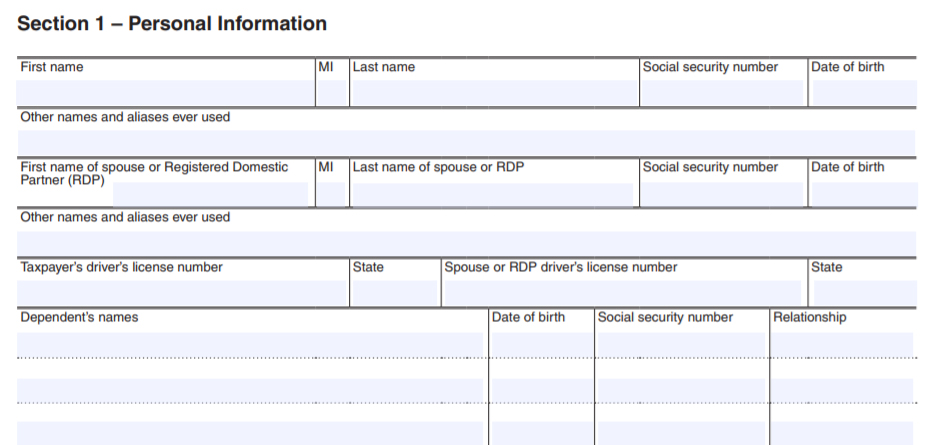
Below is a brief video that explains the process and from there you can judge if it is worth proceeding. The video is further down and the remaining information on the page explains the entire process step by step.
California FTB Offer In Compromise - Tax Attorney Explains Who Qualifies and How It WorksCalifornia taxpayers and former taxpayers that can prove they do not have the ability to pay their past due California Franchise Tax Board (“FTB”) state income tax liability can try to settle their tax debt for less than the full amount owed through an FTB Offer In Compromise (“OIC”). The FTB is looking to see what they can collect from the taxpayer over a reasonable time period. An FTB Offer In Compromise is usually more difficult than getting an IRS Offer In Compromise accepted. IRS Offer In Compromise acceptance does not guarantee acceptance of a settlement from the California FTB.
Our firm has done a lot of Franchise Tax Board Offers In Compromise. Our tax attorneys started in California and there are many people here where our office is in Las Vegas that used to live in California who still have tax debt from the state when they lived there. We also handle cases from clients nationwide, many of them being from California.
In this guide, i will explain how the FTB Offer In Compromise procedure for individuals works, what you need, and how to do it. It should be noted, that unlike in New York State Offer In Compromise where the same entity handles sales and income tax, the FTB does not handle sales tax debts. The California Board of Equalization handles sales tax debts, and an Offer In Compromise for sales tax debt is filed on different forms with them. You can also see a video version of this guide below.
Offer In Compromise: California - FTB Tax Debt Settlement - $250,000 Debt Settled For $500!!The FTB takes into account the following factors of a taxpayers financial situation when deciding to accept an Offer In Compromise:
You can only submit an Offer In Compromise twice on the same liability.
Some boxes must be checked before proceeding on an FTB Offer In Compromise. Make sure the following are complete:
There are a few things on FTB tax settlements that are different than the IRS and other states. We will go through these in detail so you know what to expect when you submit an FTB Offer In Compromise.
If the FTB thinks they can get more money out of you in the future, they may offer a collateral agreement. This gives the FTB the right to take a specified percentage of your income for the next five years if it exceeds a certain amount. This sometimes can be a condition of FTB Offer In Compromise acceptance. The majority of the time the FTB does not require one of these agreement types. Once approved it usually is over though.
By submitting an FTB Offer In Compromise and signing the paperwork, you are consenting to the FTB doing a thorough investigation on your financial information. If you do not disclose financial information, most of the time the FTB will find it anyway. Make sure everything you report to the FTB or your tax attorney preparing your FTB Offer In Compromise is accurate and complete.
The FTB typically wants a lump sum payment for your settlement amount. You do not need to offer a certain percentage of the debt and we have settled very large debts for low amounts. An FTB Offer In Compromise was accepted for $500 on an over $200,000 debt that our firm did recently. It depends on your financial situation what kind of settlement you will get. This client only had Social Security Income.
The FTB will request the following information to process your Offer In Compromise along with FTB Form 4905 PIT. All the information except for FTB Form 4905 PIT should be copied.
I will go section by section through the FTB Offer In Compromise form. Much of it is self-explanatory and will be noted as such.

Just basic information on this part of the FTB Offer In Compromise
This section is just basic personal information. It will ask also for your spouse’s information and that of your dependents. The Power of Attorney section on the bottom of the page would be filled out by your tax representative if you have one. Leave it blank if you are representing yourself.
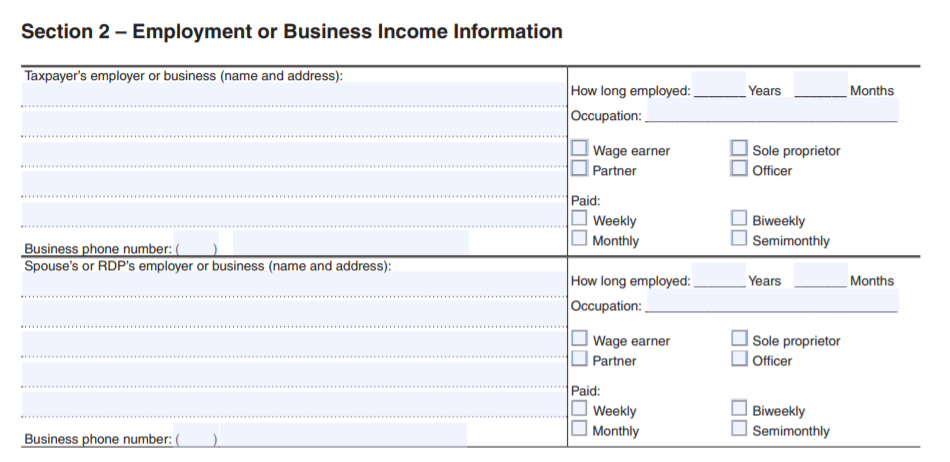
Income information goes in this section.
Fill out the basics of where you and your spouse work. Try to be as accurate as possible. If you do not know the exact month you started, they are not going to reject your settlement over it. What you submit here should match the paperwork you are submitting with the Offer In Compromise listed above.
This section goes through all the basics of your financials. Fill out as accurately as possible.
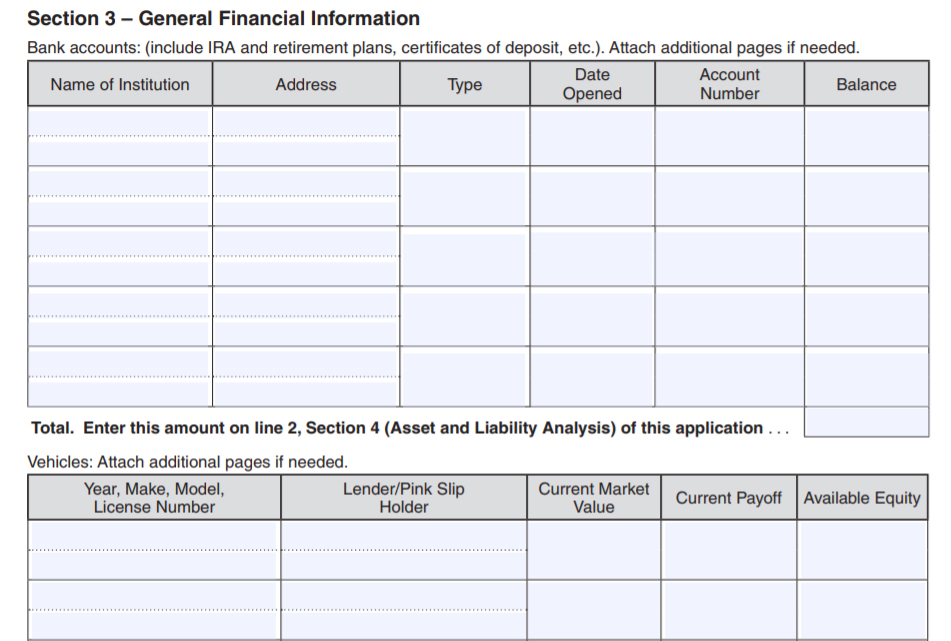
This section covers your financial information
Here you are going to list all bank accounts, certificates of deposit, and bank CDs. This should also match the paperwork submitted with the Offer.
List all information for all vehicles you have. Include cars, trucks, RV’s, ATVs, and trailers, and any other type of vehicle that is registered with any state besides watercraft and aircraft. List watercraft and aircraft in Section 4.
Input basic information for life insurance. Generally, term life insurance is not going to have a cash or surrender value. Term life insurance is the most popular form of life insurance. The cashable value of whole life insurance is usually included in your settlement total.
List your stocks, bonds, mutual funds, money market funds, and any other types of financial accounts here. This should match the paperwork you are submitting.
Most people do not have a safe deposit box and you can just write N/A in this section if you do not have one. Enter in details if you do.
Enter information for all real property that you own.
List all credit cards and lines of credit you have. Fill this information out the best you can.
Most people will check no to most of the Yes/No questions. The last California income tax return filed is usually the most recent tax year if you live in California. If you live out of state, write in the last once you filed. If you do not file the required returns your offer will get rejected. You then have to file the missing returns and resubmit. The FTB sometimes makes exceptions with very old years. Your tax attorney can find this out for you if they are working on your case. If you are unsure and ask if older tax years are required to submit call the FTB Offer In Compromise department.
Total exemptions you claim from the return are the total amount of dependents you have, including yourself. Find your adjusted gross income on line 37 of your IRS Form 1040 (bottom of the first page).
This is self-explanatory. They are trying to see if you gave anything away of value for free or less than what it is worth when you should have sold it to pay back taxes.
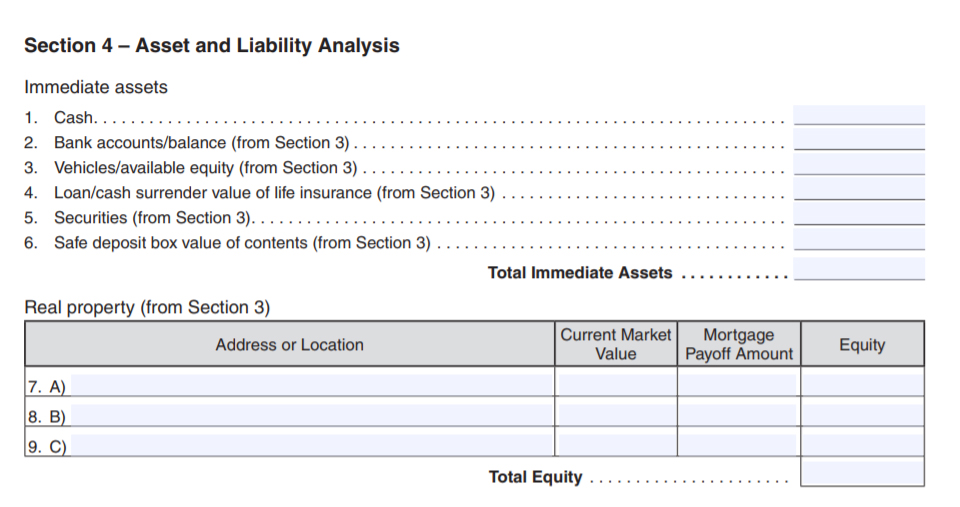
Assets and Liabilities are listed here.
Here the FTB is looking at what you have to offer in total. Cash is the only new information provided here. Put whatever cash you have on hand. The rest of the items take from what you listed in Section 3. Total up the figure at the bottom.
Here you just put the same data from Section 3 in a different format. Total up your real property equity at the bottom of this section.
Here I will list each subsection and what to put in there:
Notes: Debts owed to you by other people
Accounts receivable: Money owed to you for work. Mostly relates to self-employed persons.
Judgments/settlements receivable: Any amounts you are owed from judgments or settlements.
Aircraft, watercraft: List any boats, jet skis, wave runners, planes, or jets you have.
Interest in trusts, e .g ., trustee, trustor, beneficiary, etc: They want to know your affiliation with any trusts. The FTB is trying to see what money or property you might be getting from it.
Interest in estates: They want to know what interests you have in any estates. They are looking to see what inheritance you might gate through estates.
Other assets: Anything else you have that could be considered an asset. They give you a few lines to add in anything else. Examples could include a tractor, music rights, and trademarks.
Total Other Assets: Here they want you to add up the total of all “other assets” listed on lines 17 through 20.
Sum of Total of Assets: The total value of all the assets, including “other assets.”
Please note the FTB misspelled judgment here, but that is the title of this section. Here is what you put in:
Total owed for lines of credit: Total amount due for credit cards and lines of credit from Section 3.
Taxes Owed to IRS: Put the total amount due and a copy of the most recent notices. If nothing put $0.
Other Liabilities, Line 24-27: Put any other liabilities that are not car loans or mortgages.
Total Liabilities: Add all the liabilities up in this section and put the total.
Enter figures on a monthly basis in this category. FTB Offer In Compromise acceptance is more likely the less income you have available at the end of the month.
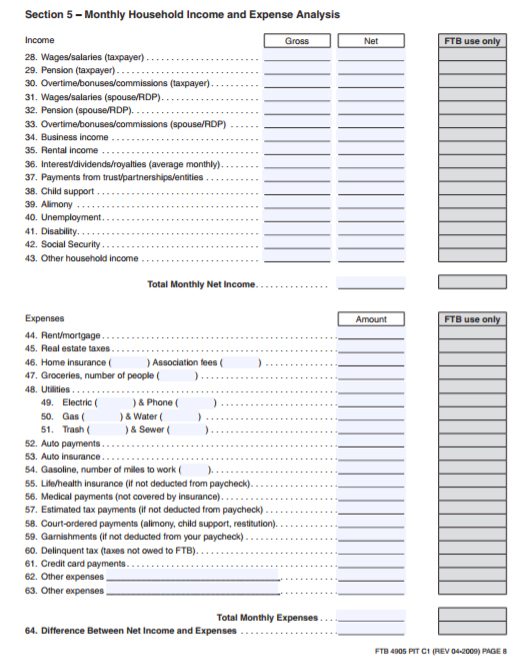
Section 5 is a little long but make sure you include everything.
List all types of income you receive in the appropriate category for you and your spouse. It is recommended to state the income type on a cover letter and include proof if you fill in the other category. They ask for gross and net. For some of these categories, gross and net may be the same. Add all the net income together and put it under “Total Monthly Net Income.”
Use a monthly figure based on last year’s income if it is at the beginning of the year if you are self-employed and do not have an exact monthly figure. If it is halfway or later through the year, make a year-to-date profit/loss statement and divide the total income by how many months have passed. Do this for both gross and net, and you will have your self-employed income figure for this part of the form.
List all your expenses. Put exact figures for everything. The only exception is groceries, where you can put your best-educated guess on the monthly amount. It should be a reasonable amount. IRS collection financial standards are not automatically accepted for this, but the amount they put for food in there has been accepted by some agents as reasonable. You can even put a bit higher if you still live in California. California is a bit more expensive than most of the country, so you might be able to spend more than that standard as well.
Add all your expenses up and write the total in the box next to “Total Monthly Expenses.”
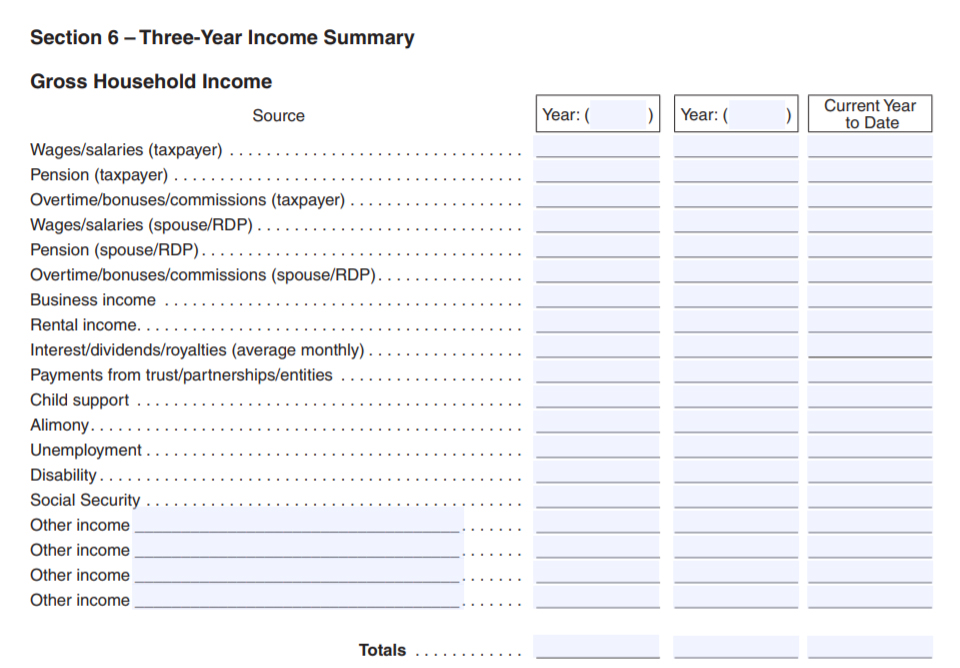
They want to know household income
Here they are looking for the details on your income over the last three years. The items are self-explanatory. On top of the parenthesis sections, write in the last two years. IE: If it is 2017, you would write 2015 and 2016, left to right. List all the income totals from each labeled source for the entire year in each column. Make sure to include details for the “Other Income” section and include copies of any documentation related to it. Add up and input the totals for each year in the appropriate Totals section below.
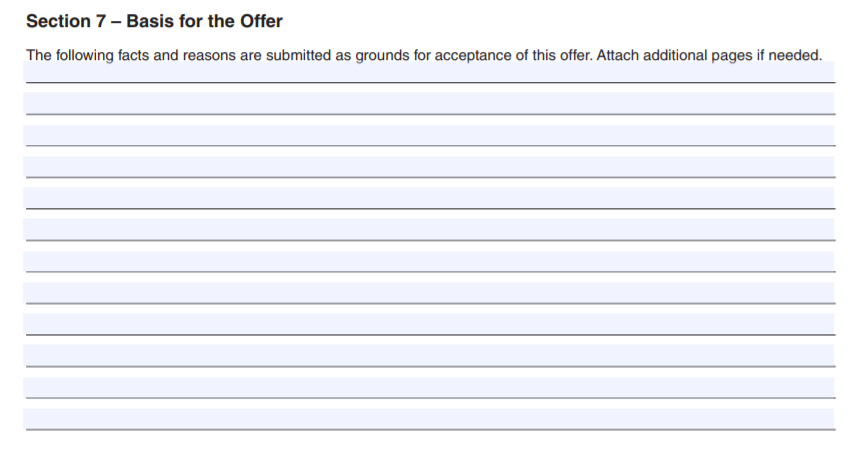
Give the best truthful sad story you can give.
The most common explanation here is that you do not have enough money to pay the tax debt. You should also list any medical conditions, age-related issues, and other reasons that would help the FTB agent feel sorry for you. Make the picture look as bleak as possible, but put what really is happening. Include copies of paperwork that support any of the points you are arguing in this section.
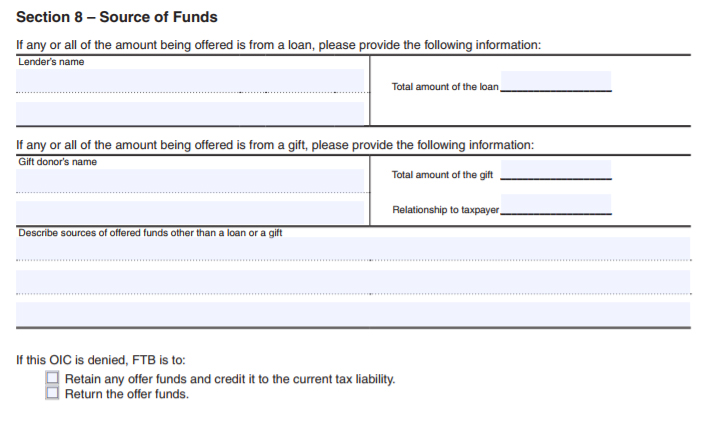
Where are you getting that settlement money? The FTB wants to know!
FTB wants to know where you will get that money to pay for your Offer In Compromise. Put your description in the bottom text box for this section if it is not a loan or gift. You can say something like “bank account” or “earned wages.”
On the check box select what you want them to do if the FTB rejects your Offer In Compromise. They do not ask for money right away. They will ask for it prior to final acceptance. For this reason, most people are going to want to check to Return the offer funds.

Short and simple.
List the total amount you owe. You (or your tax attorney) can get this total by calling the FTB. List all the years for which you owe. While the IRS will automatically make you include all years and send you an amended Offer if you miss something, the FTB will not. It is very important to include all years here. Enter the lump sum you are offering. If you have no income or assets, offer $100-500. The FTB may come back with a higher figure, but I say start low go higher. I have only seen it go the other way once. A very nice agent let one of our clients who was taking care of disabled children not pay anything towards the settlement and forgave the debt completely when we had offered $100.
Do not send any funds with the Offer. FTB will tell you to submit the settlement funds. It still then is subject to review. The FTB Offer In Compromise is not complete even if recommended for acceptance by the agent, but it is a pretty good sign. The case must pass the final review.
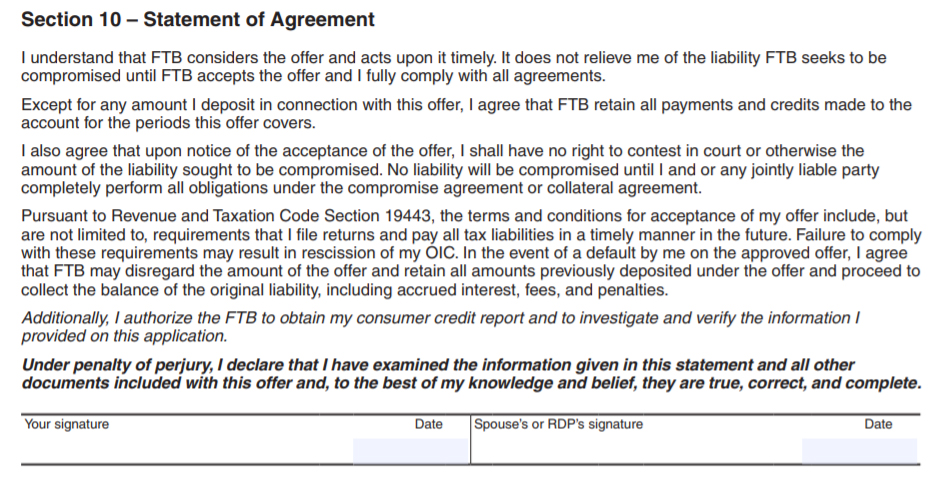
The offer terms are pretty fair.
This is where you agree to the offer terms. Sign and date at the bottom if you agree and note that debts cannot be contested later in court. You agree that you will file on time and keep current in the future on taxes due. Note that the IRS requires you to keep current on taxes due and file on time for five (5) years. The FTB does not specify a time limit on this.
Sign and date on the bottom. Have your spouse sign and date as well if you have joint FTB tax debts.
Include a cover letter explaining anything that cannot be explained by the FTB Offer In Compromise forms in addition to the above-referenced information . Your tax attorney will most likely put a cover letter on it for you if they are preparing it. The offer should be sent by certified mail with a return receipt. You or your tax attorney should contact FTB collections if your case is in collections (or if you are unsure) and let them know you have submitted an FTB Offer In Compromise. Most of the time they put a collection hold on the case until the Offer In Compromise evaluation is over. The FTB however, unlike the IRS, does reserve the right to proceed with collection action while the Offer is pending.
After submission, you should get a response within 90 days. FTB settlements are often faster than the IRS, the average being 3-5 months time. We hope this guide helps explain the process and can help you to get your own FTB Offer In Compromise even if you cannot afford professional help.
Don’t want to do it yourself? Prefer to have our expert tax attorneys do it for you? Fill out the contact form here or call us at (888) 515-4829. One of our tax attorneys will call you for a free, no-obligation consultation.